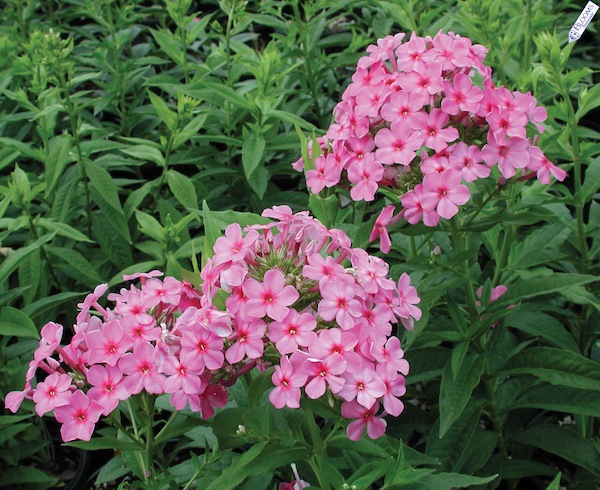
'Shortwood' garden phlox got the highest marks in Chicago Botanic Garden trials. Photo courtesy Bloom of Bressingham North America
One of the longest blooming perennials in the garden is phlox, frequently called garden or border phlox. This phlox (P. paniculata) is an Eastern United States’ native plant. Large flower heads attract butterflies, hummingbirds and other pollinating insects. It’s also an excellent cut flower. Many are fragrant.
[download id=”57″ format=”2″] is the second evaluation of this popular perennial in 20 years. In the first trial, 20 varieties were evaluated from 1993 to 1996. Since then, many new cultivars have been introduced. From 2001 to 2009, researchers evaluated 78 varieties of garden phlox.
The perennials were grown in full sun in soil that was amended with compost. Plants were mulched with composted leaves, but not fertilized or treated for insect or disease. Plants were watered as needed with overhead sprinklers. Planting beds were fenced to keep out deer.
Researchers evaluated all aspects of the phlox, such as flowering time, size and number of blooms, strength of stems and overall plant health. As most gardeners know, powdery mildew on the phlox was the biggest problem researchers noted. The second biggest problem was mites.
‘Shortwood’ was the only phlox that garnered excellence with five stars “for its exceptional overall performance and superior resistance to powdery mildew and spider mites,” wrote Richard G. Hawke, the CBG’s plant evaluation manager.
Introduced by Blooms of Bressingham, ‘Shortwood’ was a chance seedling of ‘David’, discovered in Pennsylvania and named for the garden of Stephanie Cohen, a noted expert on perennials and author of many books.
The award-winning phlox has rosy pink flowers on plants that get about 4 feet tall.
To fight powdery mildew, the CBG recommends selecting resistant varieties, providing adequate ventilation by removing 25 percent of the stems, avoiding overhead watering and removing any plant debris.
Other highly rated phlox
These phlox (Phlox paniculata, P. x arendsii) displayed the greatest resistance to powdery mildew in all years of the trial at the Chicago Botanic Garden:
- ‘Candy Floss’
- ‘Sherbert Cocktail’
- ‘Flower Power’
- ‘Bartwelve’
- ‘Becky Towe’
- ‘Frosted Elegance’
- ‘Giltmine’
- ‘Goldmine’
- ‘John Fanick’
- ‘Lichtspel’
- ‘Natural Feelings’
- ‘Peppermint Twist’
- ‘Pleasant Feelings’
- ‘Rainbow’
- ‘Rubymine’
- ‘Shortwood’
- ‘Swirly Burly’
- ‘Wendy House’
Powdery mildew
Symptoms of this disease are observed in summer and autumn when the development of the fungus is promoted by high temperatures and high night-time humidity. The reproductive spores are carried by wind and germinate under humid conditions. Selecting mildew-resistant cultivars is the first line of defense against the disease. Unfortunately, the resistance or susceptibility of specific garden phlox cultivars to powdery mildew varies by geographic location.
A number of cultural practices may eliminate or reduce mildew in the garden. Management considerations include:
- thinning out a fourth of the stems to increase air circulation through the plant
- planting in full sun
- eliminating or reducing overhead irrigation;
- reducing the overwintering spores through removal of infected leaves and stems each autumn
Fungicides or horticultural oils and soaps can also be helpful in controlling the fungus. Always read and follow the label directions of the products you use.
Research at Cornell University determined that a mixture of one tablespoon of baking soda and one teaspoon of lightweight horticultural oil or insecticidal soap in a gallon of water applied weekly helps to control powdery mildew.